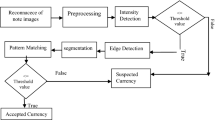Abstract
In this paper, we propose a novel paper currency defect detection algorithm using quaternion uniform strength. We first build paper currency image preprocessing integration framework which includes intensity balancing, paper currency location, and geometric correction. We then propose a global–local paper currency image registration algorithm by moving key areas within certain range which can eliminate the false difference effectively. Finally, the quaternion uniform strength is calculated by using quaternion convolution edge detector. The defect degree of paper currency is determined by using the quaternion uniform color difference. The proposed algorithm is tested using different datasets from five countries: CNY, USD, EUR, VND, and RUB. The experimental results demonstrate that the proposed algorithm yields better results than the existing state-of-the-art paper currency defect detection techniques. The demo of the proposed paper currency defect detection algorithm will be publicly available.














Similar content being viewed by others
References
Jin Y, Song L, Tang XL, Du M (2008) A hierarchical approach for paper currency image processing using homogeneity and FFD model. IEEE Signal Proc Lett 15(6):425–428
Dirk L, Pieter S, Frederik M, Dirk V, Paul S (2010) Nonrigid image registration using conditional mutual information. IEEE Trans Med Imaging 29(1):19–29
Huang XL, Paragios N, Metaxas DN (2006) Shape registration in implicit spaces using information theory and free form deformations. IEEE Trans Pattern Anal Mach Intell 28(8):1303–1318
Jin Y, Liu SB, Liu JF, Song L, Tang XL (2007) An edge-based defect detection algorithm for paper currency. J Comput Res Dev 44(2):258–264
Liu SG, Cai QP (2019) Shape-optimizing and illumination-smoothing image stitching. IEEE Trans Multimed 21(3):690–703
Lou ZY, Theo G (2014) Image alignment by piecewise planar region matching. IEEE Trans Multimedia 16(7):2052–2061
Takeda F, Omatu S (1995) High speed paper currency recognition by neural networks. IEEE Trans Nerual Netw 6(1):73–77
Frosini A, Gori M, Priami P (1996) A neural network-based model for paper currency recognition and verification. IEEE Trans Nerual Netw 7(6):1482–1490
Takeda F, Nishikage T, Omatu S (1999) Paper currency recognition by means of optimized masks, neural networks and genetic algorithms. Eng Appl Artif Intell 12(8):175–184
Sharma B, Vipan AK (2012) Recognition of Indian paper currency based on LBP. Int J Comput Appl 59(1):24–27
Garcia-Lamont F, Cevantes J, Lopez A (2012) Recognition of Mexican paper currencys via their color and texture features. Expert Syst Appl 30(10):9651–9660
Guo JF, Zhao YY, Cai A (2010) A reliable method for paper currency recognition based on LBP. In: Proceedings of the IEEE international conference on network infrastructure and digital content, Beijing, China, 2010, pp 24–26
Takeda F, Omatu S, Onami S (1993) Recognition system of US dollars using a neural network with random masks. In: Proceedings of the IEEE international conference on neural networks, Nagoya, Japan, 1993, pp 25–29
Takeda F, Nishikage T (2000) Multiple kinds of paper currency recognition using neural network and application for Euro currency. In: Proceedings of IEEE international conference on neural networks, Como, Italy, 2000, pp 143–147
Song D, Tao D (2010) Biologically inspired feature manifold for scene classification. IEEE Trans Image Process 19(1):174–184
Liu JF, Liu SB, Tang XL (2003) An algorithm of real-time paper currency recognition. J Comput Res Dev 40(7):1057–1061
Youn S, Choi E, Baek Y, Lee C (2015) Efficient multi-currency classification of CIS paper currencys. Neurocomputing 156(25):22–32
Ionescu M, Ralescu A (2005) Fuzzy hamming distance based paper currency validator. In: Proceedings of IEEE international conference on fuzzy systems, Reno, NV, USA, 2005, pp 300–305
Pham TD, Kim KW, Kang JS, Park KR (2017) Banknote recognition based on optimization of discriminative regions by genetic algorithm with one-dimensional visible-light line sensor. Pattern Recogn 72(1):27–43
Baek S, Choi E, Baek Y, Lee C (2018) Detection of counterfeit banknotes using multispectral images. Digit Signal Proc 78(1):294–304
Youn S, Choi E, Baek Y, Lee C (2015) Efficient multi-currency classification of CIS banknotes. Neurocomputing 156(1):22–32
Choi E, Lee J, Yoon J (2006) Feature extraction for paper currency classification using wavelet transform. In: Proceedings of IEEE international conference on pattern recognition, Hong Kong, China, 2006, pp 20–24
Gai S (2016) New paper currency defect detection algorithm using quaternion wavelet transform. Neurocomputing 196(5):133–139
Hassanpour H, Farahabadi PM (2009) Using hidden markov models for paper currency recognition. Expert Syst Appl 36(6):10105–10111
Yeh CY, Su WP, Lee SJ (2011) Employing multiple-kernel support vector machines for counterfeit paper currency recognition. Appl Soft Comput 11(1):1439–1447
Faiz MH, Yang XD, Tian YL (2012) Robust and effective component-based paper currency recognition for the blind. IEEE Trans Syst Man Cybern Part C Appl Rev 42(6):1021–1030
Ma JB, Teng GF (2019) A hybrid multiple feature construction approach for classification using Genetic Programming. Appl Soft Comput 80(6):687–699
Zhang Y, Rockett PI (2018) A generic optimizing feature extraction method using multiobjective genetic programming. Appl Soft Comput 11(1):1087–1097
Moxey CE, Sangwine SJ, Ell TA (2003) Hypercomplex correlation techniques for vector images. IEEE Trans Signal Process 51(7):1941–1953
Acknowledgements
This work is partially supported by National Natural Science Foundation of China under Grant 61563037, 61866027; The Jiangxi Science Fund for Distinguished Young Scholars under Grant 20192ACB21032; Outstanding Youth Scheme of Jiangxi Province under Grant 20171BCB23057; Key research project of Jiangxi Province under Grant 20171BBE50013.
Author information
Authors and Affiliations
Corresponding author
Ethics declarations
Conflict of interest
The authors declare that they have no conflicts of interest.
Additional information
Publisher's Note
Springer Nature remains neutral with regard to jurisdictional claims in published maps and institutional affiliations.
Rights and permissions
About this article
Cite this article
Gai, S., Xu, X. & Xiong, B. Paper currency defect detection algorithm using quaternion uniform strength. Neural Comput & Applic 32, 12999–13016 (2020). https://doi.org/10.1007/s00521-020-04745-6
Received:
Accepted:
Published:
Issue Date:
DOI: https://doi.org/10.1007/s00521-020-04745-6




